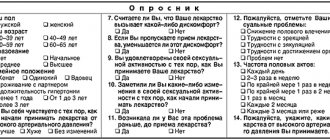Losartan-N Canon tablets 12.5 mg+50 mg 30 pcs.
Losartan. Can be used simultaneously with other antihypertensive drugs. There were no clinically significant drug interactions between losartan and hydrochlorothiazide, digoxin, warfarin, cimetidine, phenobarbital, ketoconazole and erythromycin. Rifampicin and fluconazole have been reported to reduce plasma concentrations of the active metabolite. The clinical significance of these interactions is currently unknown. As with the use of other drugs that block the formation of angiotensin II and its effects, the concomitant administration of potassium-sparing diuretics (spironolactone and eplerenone, triamterene, amiloride), potassium supplements and salts containing potassium may lead to an increase in the content of potassium ions in the blood serum. Antihypertensive drugs may increase the antihypertensive effect of losartan. Tricyclic antidepressants, antipsychotics, baclofen, amifostine, which reduce blood pressure as a main or side effect and may increase the risk of arterial hypotension, can also enhance the antihypertensive effect of losartan. With simultaneous use of angiotensin II receptor antagonists and nonsteroidal anti-inflammatory drugs (NSAIDs) (including selective cyclooxygenase-2 inhibitors, acetylsalicylic acid as an anti-inflammatory agent), the antihypertensive effect of losartan may be reduced. In patients with impaired renal function, concomitant use of angiotensin II receptor antagonists or diuretics and NSAIDs may cause a further deterioration of renal function, including acute renal failure and an increase in serum potassium. This combination should be used with caution, especially in elderly patients. With simultaneous use of lithium with ACE inhibitors, a reversible increase in the concentration of lithium in the blood serum and the development of toxicity were recorded; in very rare cases this has been observed with the use of angiotensin II receptor antagonists. Caution should be used when lithium is used concomitantly with losartan. If this combination is necessary, it is recommended to monitor the concentration of lithium in the blood serum. Mutually enhances the effect of beta-blockers and sympatholytics; combined use of losartan with diuretics causes an additive effect. Dual blockade of the RAAS (eg, by combining an angiotensin II receptor antagonist with an ACE inhibitor or aliskiren) in patients with established atherosclerosis, heart failure, or diabetes mellitus with end-organ damage is associated with a higher incidence of hypotension, syncope, hyperkalemia, and dysfunction. kidneys (including the development of acute renal failure) compared with the use of a single-component blockade of the RAAS. The issue of using double blockade of the RAAS should be decided in each case individually and with careful monitoring of blood pressure, water-electrolyte balance of the blood and renal function. Hydrochlorothiazide. With thiazide diuretics, drugs such as ethanol, barbiturates and narcotics may potentiate the risk of orthostatic hypotension. Hypoglycemic agents (oral and insulin) - dosage adjustment of hypoglycemic agents may be required. Metformin should be used with caution due to the risk of lactic acidosis due to possible renal failure associated with hydrochlorothiazide. Other antihypertensive drugs – additive effects are possible. Corticosteroids, ACTH (adrenocorticotropic hormone) - a marked decrease in electrolyte levels, in particular hypokalemia. Pressor amines (for example, epinephrine, norepinephrine) - decreased response to pressor amines. Muscle relaxants of a non-depolarizing type of action (for example, tubocurarine) - enhance the effect of muscle relaxants. Lithium - diuretics reduce the renal clearance of lithium and increase the risk of lithium toxicity; simultaneous use is not recommended. NSAIDs (including cyclooxygenase-2 inhibitors) - may reduce the diuretic, natriuretic and antihypertensive effects of diuretics. Probenecid, sulfinpyrazone, allopurinol - co-administration with drugs for the treatment of gout may require dose adjustment of these drugs, since hydrochlorothiazide can increase the concentration of uric acid in the blood serum: increase the dose of probenecid or sulfinpyrazone. Concomitant use of thiazide diuretics may increase the incidence of hypersensitivity to allopurinol. Anticholinergics (atropine, biperiden) - increase the bioavailability of thiazide diuretics due to a decrease in gastrointestinal motility and the rate of gastric emptying. Cytotoxic drugs (cyclophosphamide, methotrexate) - Thiazides can reduce the renal excretion of cytotoxic drugs and stimulate their myelotoxic effect. Salicylates - when taking high doses of salicylates, hydrochlorothiazide can enhance their toxic effect on the central nervous system. Methyldopa: Cases of hemolytic anemia have been reported separately with the concomitant use of hydrochlorothiazide and methyldopa. Cyclosporine - co-administration with cyclosporine may increase the risk of hyperuricemia and gout-like complications. Cardiac glycosides - Thiazide-stimulated hypokalemia or hypomagnesemia may contribute to the development of cardiac arrhythmias when co-administered with cardiac glycosides. Medicines that can cause aritis. Due to the risk of hypokalemia, caution is required when using Losartan-N Canon simultaneously with the following drugs that can cause torsade de pointes: antiarrhythmic drugs (for example, quinidine, hydroquinidine, disopyramide, amiodarone, sotalol) some antipsychotic drugs (for example, thioridazine, chlorpromazine, levomepromazine, trifluoperazine, cyamemazine, sulpiride, sultopiride, amisulpiride, tiapride, pimozide, haloperidol, droperidol); others (eg, bepridil, cisapride, difemanil, erythromycin IV, halofantrine, mizolastine, pentamidine, terfenadine, vincamycin IV, saprofloxacin, moxifloxacin, astemizole). Calcium salts - thiazide diuretics can increase the calcium level in the blood serum due to a decrease in its excretion. If it is necessary to use calcium supplements, the dose is selected under the control of calcium levels in the blood serum. Vitamin D - increases the risk of hypercalcemia. Impact on laboratory results - Due to their effect on calcium excretion, thiazides may interfere with the results of tests of parathyroid function. Carbamazepine – increases the risk of symptomatic hyponatremia. Serum sodium levels must be monitored. Iodine contrast agents – with dehydration caused by taking diuretics, the risk of developing acute renal failure increases, especially when high doses of iodine-containing drugs are administered. Before administering such drugs, the patient must be rehydrated. Amphotericin B, corticosteroids, adrenocorticotropic hormone and laxatives - when used together, hydrochlorothiazide can aggravate electrolyte imbalances, especially causing the development of hypokalemia.
Losartan
Hypersensitivity reactions
In patients with a history of angioedema (swelling of the face, lips, pharynx/larynx and/or tongue), monitoring of the use of the drug is necessary.
Embryotoxicity
The use of drugs that affect the RAAS during the second and third trimester of pregnancy reduces fetal renal function and increases fetal and neonatal morbidity and mortality. The development of oligohydramnios may be associated with fetal lung hypoplasia and skeletal deformation. Possible adverse events in neonates include calvarial hypoplasia, anuria, hypotension, renal failure and death. If pregnancy is established, losartan should be discontinued immediately (see Use during pregnancy and breastfeeding).
Arterial hypotension and water-electrolyte imbalance or decreased circulating blood volume (CBV)
In patients with reduced blood volume (for example, those receiving treatment with large doses of diuretics), symptomatic arterial hypotension may occur. Correction of such conditions must be carried out before prescribing losartan or starting treatment with a lower dose of the drug (see Dosage and Administration). Fluid and electrolyte imbalance is common in patients with impaired renal function with or without diabetes mellitus, so careful monitoring of these patients is necessary.
During treatment with losartan, it is not recommended to take potassium-sparing diuretics, potassium supplements, or potassium-containing salt substitutes without prior consultation with your doctor.
Aortic or mitral stenosis, hypertrophic obstructive cardiomyopathy
Like all drugs that have a vasodilating effect, ARA II should be prescribed with caution to patients with aortic or mitral stenosis or hypertrophic obstructive cardiomyopathy.
Coronary heart disease and cerebrovascular diseases
Like all drugs that have a vasodilating effect, ARA II should be prescribed with caution to patients with coronary heart disease or cerebrovascular diseases, since an excessive decrease in blood pressure in this group of patients can lead to the development of myocardial infarction or stroke.
Chronic heart failure
As with the use of other drugs that act on the RAAS, in patients with CHF and with or without impaired renal function, there is a risk of developing severe arterial hypotension or acute renal dysfunction. Since there is insufficient experience with the use of losartan in patients with heart failure and concomitant severe renal impairment, in patients with severe heart failure (NYHA functional class IV), as well as in patients with heart failure and symptomatic life-threatening arrhythmias, losartan should be prescribed with caution in patients of these groups.
Primary hyperaldosteronism
Since patients with primary hyperaldosteronism generally do not respond well to therapy with antihypertensive drugs that act by inhibiting the RAAS, the use of losartan is not recommended in this group of patients.
Liver dysfunction
Data from pharmacokinetic studies indicate that plasma concentrations of losartan in patients with liver cirrhosis are significantly increased, so patients with a history of impaired liver function should be prescribed the drug at a lower dose. There is no experience with the use of losartan in patients with severe liver dysfunction, so the drug should not be used in this group of patients).
Renal dysfunction
Due to inhibition of the RAAS, changes in renal function, including the development of renal failure, have been observed in some susceptible patients. These changes in renal function may return to normal after treatment is stopped.
Some drugs that affect the RAAS may increase blood urea and serum creatinine concentrations in patients with bilateral renal artery stenosis or renal artery stenosis of a solitary kidney. Similar effects have been reported with losartan.
Such renal dysfunction may be reversible after discontinuation of therapy.
Dual blockade of the renin-angiotensin-aldosterone system (RAAS)
The simultaneous use of angiotensin II receptor antagonists with drugs containing aliskiren is contraindicated in patients with diabetes mellitus and/or with moderate or severe renal impairment (GFR less than 60 ml/min/1.73 m2 body surface area) and is not recommended in other patients.
Concomitant use of angiotensin II receptor antagonists with ACE inhibitors is contraindicated in patients with diabetic nephropathy and is not recommended in other patients.
Special patient groups
Race
The ability of losartan, compared with atenolol, to reduce the risk of stroke and myocardial infarction, as well as reduce cardiovascular mortality in patients with hypertension and left ventricular hypertrophy, does not apply to black patients, although both treatment regimens effectively reduced blood pressure in these patients.
Children and teenagers
The effectiveness and safety of losartan in children and adolescents under 18 years of age have not been established.
If oliguria or arterial hypotension develops in newborns whose mothers took losartan during pregnancy, symptomatic therapy aimed at maintaining blood pressure and renal perfusion is necessary. Blood transfusions or dialysis may be required to prevent hypotension and/or maintain renal function.
Elderly patients
Clinical studies have not revealed any particularities regarding the safety and effectiveness of losartan in elderly patients (over 65 years of age).
Lactose
The drug contains lactose monohydrate. It must be taken into account that the use of the drug is contraindicated in patients with rare congenital galactose intolerance, lactase deficiency or glucose-galactose malabsorption.
Features of the action of the drug at the first dose
Patients with reduced blood volume (for example, when taking high doses of diuretics, limiting salt intake, diarrhea or vomiting) may develop symptomatic hypotension, especially after taking the first dose and after increasing the dose of the drug.
Features of the action of the drug upon its withdrawal
You should not stop taking the drug without consulting a doctor, as symptoms may return.
Features of the actions of a doctor (paramedic) or patient when one or more doses of a drug are missed
If you miss a dose of the drug, you must take the next dose at your usual time. Do not take a double dose to make up for a missed dose.

